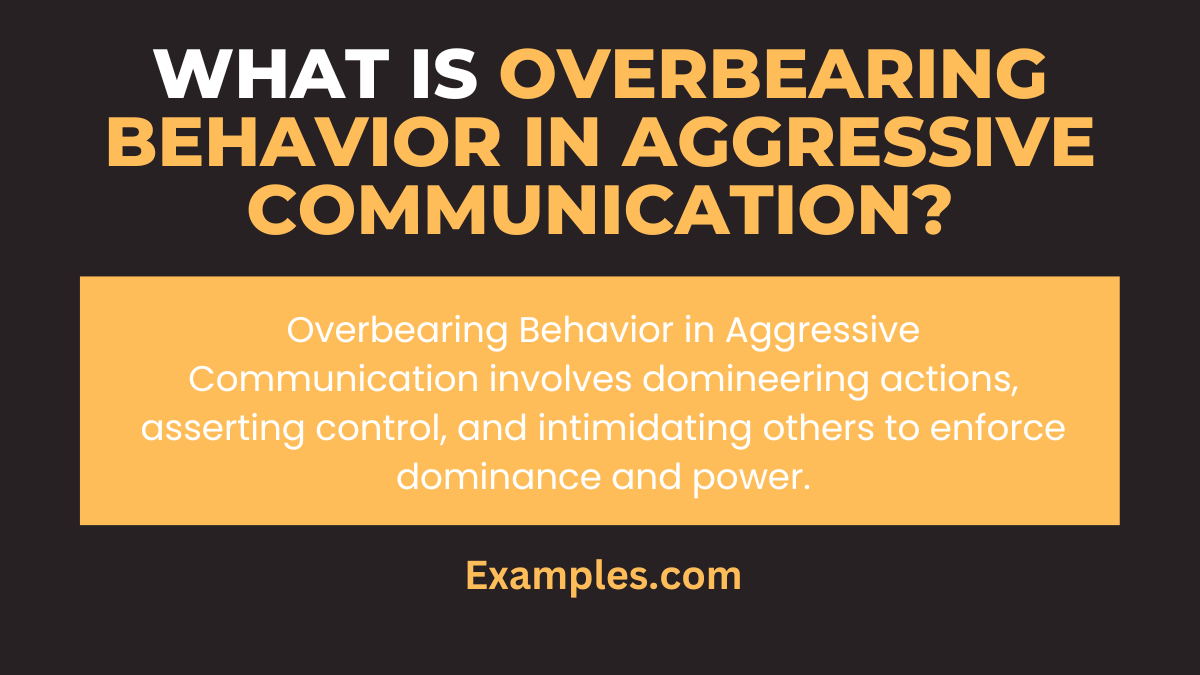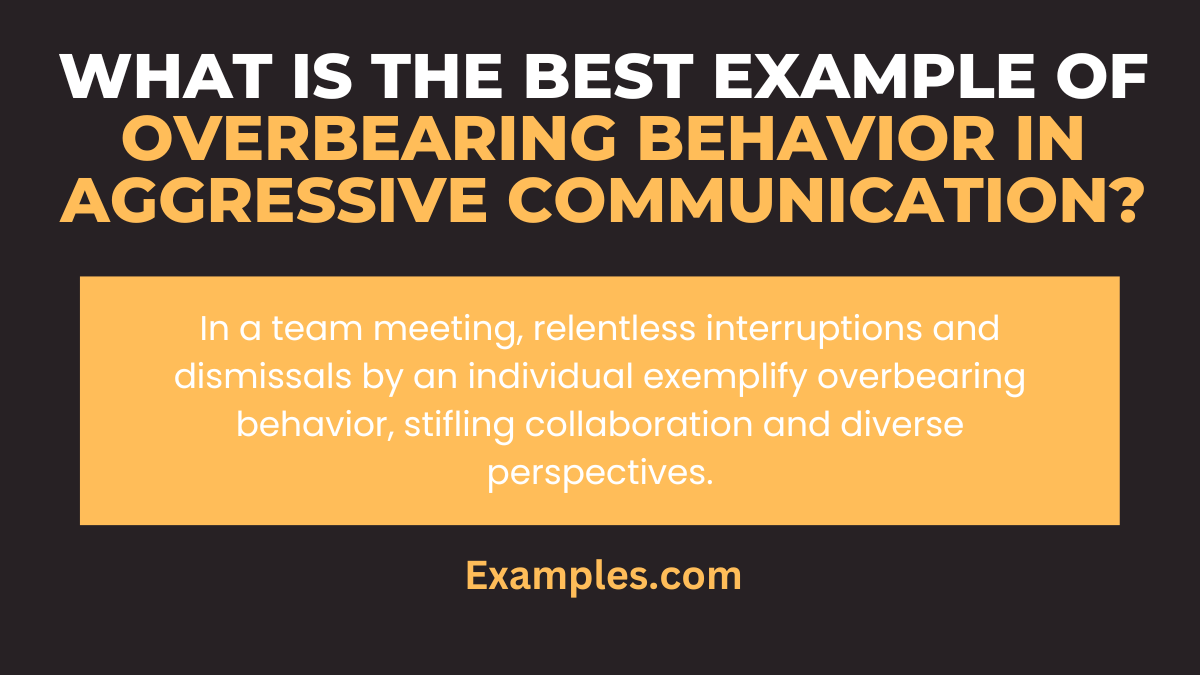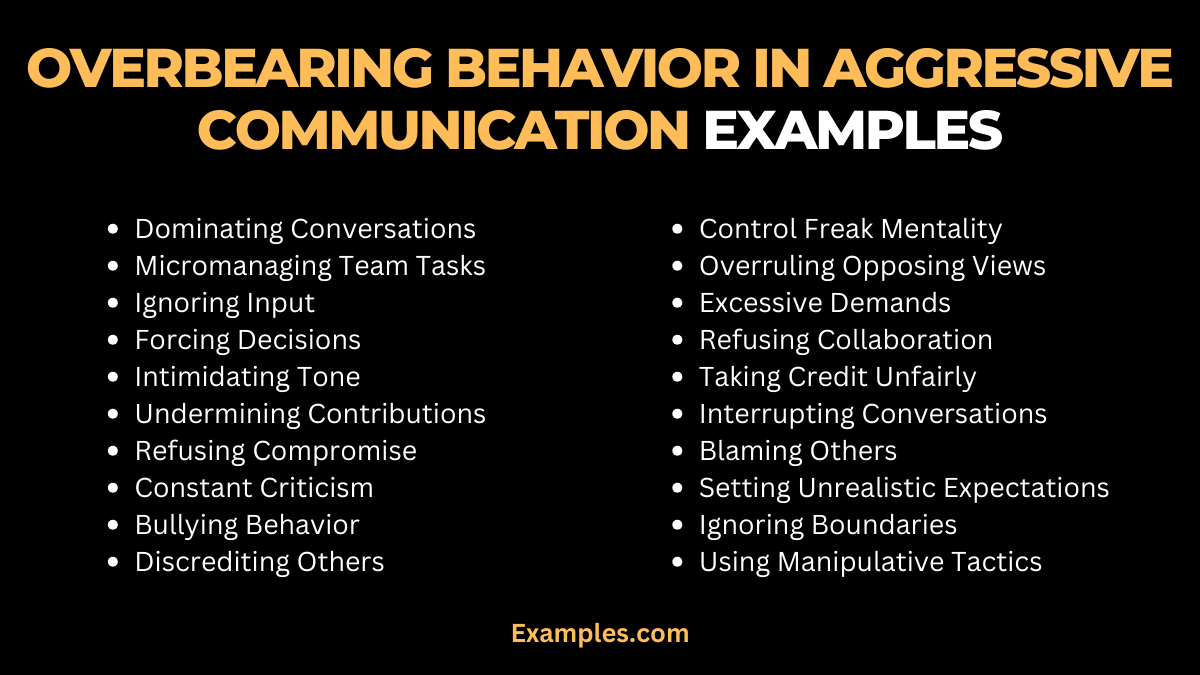19+ Overbearing Behavior in Aggressive Communication Examples
Unlock the complexities of Overbearing Behavior in Aggressive Communication with our comprehensive guide. Delve into real-life scenarios, expert insights, and invaluable tips to navigate and understand the nuances of communication. This complete resource empowers you to recognize, manage, and transform overbearing encounters into constructive interactions. Elevate your communication skills with vivid Communication Examples that illuminate the path to assertiveness and understanding.
What is Overbearing Behavior in Aggressive Communication?

In the realm of communication, Overbearing Behavior refers to an assertive and dominating manner that exceeds acceptable norms. This intrusive conduct often involves imposing one’s views forcefully, disregarding others’ opinions. Recognizing this dynamic in aggressive communication is crucial for fostering healthier interpersonal relationships. Understanding the traits and impact of overbearing behavior is pivotal to navigating assertiveness within social and professional spheres.
What is the Best Example of Overbearing Behavior in Aggressive Communication?

Imagine a team meeting where one individual consistently interrupts and dismisses colleagues’ ideas, imposing their viewpoint forcefully. This overbearing behavior creates an unhealthy dynamic, hindering collaboration and stifling diverse perspectives. Such instances showcase the negative impact of overbearing conduct in aggressive communication, highlighting the need for fostering open dialogue and respect within team interactions.
20 Overbearing Behavior in Aggressive Communication Examples

Overbearing behavior in aggressive communication is characterized by an excessive and dominating approach that suppresses others’ input. This inhibits effective collaboration and fosters a hostile environment. Examples of such behavior manifest in various situations, impacting interpersonal relationships and work dynamics. Understanding and addressing these instances is crucial for promoting healthier communication.
- Dominating Conversations: Constantly interrupting others to assert dominance in discussions.
- Micromanaging Team Tasks: Overly controlling and scrutinizing team members’ work, impeding autonomy.
- Ignoring Input: Dismissing others’ suggestions without consideration or acknowledgment.
- Forcing Decisions: Imposing decisions without seeking consensus or considering alternative viewpoints.
- Intimidating Tone: Using a harsh and intimidating tone to communicate, creating a hostile atmosphere.
- Undermining Contributions: Belittling or demeaning others’ ideas and contributions during group discussions.
- Refusing Compromise: Unwillingness to negotiate or compromise, insisting on personal preferences.
- Constant Criticism: Offering relentless criticism without constructive feedback, fostering negativity.
- Bullying Behavior: Engaging in bullying tactics, such as name-calling or insults, to establish dominance.
- Discrediting Others: Undermining the credibility of colleagues by questioning their competence openly.
- Control Freak Mentality: Insisting on controlling every aspect of a situation, limiting others’ decision-making power.
- Overruling Opposing Views: Disregarding opposing views outright, refusing to acknowledge differing perspectives.
- Excessive Demands: Making unreasonable demands without considering the feasibility or impact on others.
- Refusing Collaboration: Avoiding collaborative efforts and disregarding the benefits of teamwork.
- Taking Credit Unfairly: Claiming credit for others’ achievements and downplaying their contributions.
- Interrupting Conversations: Frequently interrupting others during conversations, diminishing their ability to express ideas.
- Blaming Others: Shifting blame onto others without taking responsibility for personal actions.
- Setting Unrealistic Expectations: Establishing goals or expectations that are impractical and unattainable for others.
- Ignoring Boundaries: Disregarding personal and professional boundaries, invading others’ personal space or responsibilities.
- Using Manipulative Tactics: Employing manipulative strategies to control situations or influence outcomes.
Overbearing Behavior in Aggressive Communication Examples at Workplace
Navigating overbearing behavior in aggressive communication within the workplace is crucial for fostering a healthy professional environment. Recognizing these instances and addressing them effectively is essential. Explore real-world examples that shed light on overbearing behavior within the workplace.
- Micromanaging Team Dynamics:
- Explanation: Constantly monitoring and controlling every aspect of team tasks, limiting autonomy and stifling creativity.
- How to Communicate: Boldly express the need for autonomy, emphasizing trust in individual capabilities.
- Ignoring Team Input:
- Explanation: Disregarding team members’ opinions and ideas during meetings, undermining collaborative efforts.
- How to Communicate: Assertively communicate the importance of diverse perspectives for comprehensive decision-making.
- Bullying and Intimidation:
- Explanation: Employing bullying tactics to intimidate colleagues, creating a hostile work environment.
- How to Communicate: Confront the behavior directly, emphasizing the need for respectful and cooperative interactions.
- Blaming Others for Failures:
- Explanation: Shifting blame onto team members without acknowledging personal responsibility for project setbacks.
- How to Communicate: Encourage open discussions on challenges, fostering a collaborative problem-solving approach.
- Undermining Colleagues’ Authority:
- Explanation: Discrediting colleagues in public settings, challenging their competence and authority.
- How to Communicate: Address concerns privately, promoting a culture of support and professional respect.
How does Overbearing Behavior contribute to Aggressive Communication dynamics?
Understanding the Impact: Overbearing behavior significantly influences aggressive communication, creating a negative dynamic. Identifying its contributions is crucial for effective communication strategies.
- Recognition of Overbearing Cues:
- Develop awareness of behaviors indicating overbearing tendencies.
- Pay attention to dominating language, micromanaging, and dismissive attitudes.
- Impact on Communication Tone:
- Analyze how overbearing behavior affects the overall tone.
- Note changes in tone, including condescension and intimidation.
- Role in Power Imbalance:
- Examine the role of overbearing behavior in power dynamics.
- Identify instances where it contributes to an imbalance within interactions.
In What Ways Can Individuals Address Overbearing Behavior in Aggressive Communication?
Navigating Overbearing Traits: Effectively addressing overbearing behavior requires specific strategies for individuals to employ in various situations.
- Direct Communication:
- Address the behavior directly through assertive communication.
- Clearly express discomfort and the need for respectful interactions.
- Establishing Boundaries:
- Set clear personal boundaries to counter overbearing tendencies.
- Clearly communicate limits on micromanagement or dismissive attitudes.
- Promoting Open Dialogue:
- Encourage open dialogue within the team or group.
- Foster an environment where concerns about overbearing behavior can be addressed openly.
What Role does Overbearing Behavior play in shaping Aggressive Communication styles?
Shaping Communication Approaches: Understanding the interplay between overbearing behavior and communication styles provides insights into its role in shaping aggressive interactions.
- Dominance as a Communication Style:
- Explore how dominance is used as a communication style.
- Identify instances where overbearing traits contribute to dominance.
- Impact on Team Dynamics:
- Assess the impact of overbearing behavior on team dynamics.
- Analyze how it influences collaboration, communication, and overall teamwork.
- Interpersonal Relationships:
- Examine the effect of overbearing behavior on interpersonal relationships.
- Note changes in relationships due to dominating communication styles.
What are the Consequences of Persistent Overbearing Behavior in Aggressive Communication?
Unraveling Long-Term Effects: Continued overbearing behavior within aggressive communication settings can lead to a range of consequences with lasting implications.
- Deterioration of Team Morale:
- Understand how ongoing overbearing behavior affects team morale.
- Note instances of decreased motivation and job satisfaction.
- Impact on Innovation and Creativity:
- Explore the consequences of stifled creativity due to overbearing tendencies.
- Identify areas where innovation is hindered by aggressive communication.
- Creation of Hostile Work Environment:
- Recognize the potential for a hostile work environment with persistent overbearing behavior.
- Assess its impact on employee well-being and overall workplace culture.
In conclusion, understanding and addressing overbearing behavior in aggressive communication is pivotal for fostering healthier interpersonal dynamics. By recognizing its impact on communication styles and acknowledging the consequences it may yield, individuals can work towards creating more positive and collaborative environments. Striving for assertive and respectful communication ensures sustained team morale and a conducive workplace culture.



